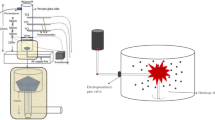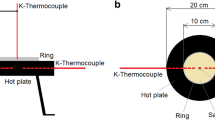Abstract
The ignition of combustible material by contact with hot metal particles is an important pathway by which wildland and urban spot fires are started. This work examines how fuel characteristics such as density, morphology and chemical composition effect the ability of the fuel to be ignited by a hot metal particle. Fuels were prepared out of three materials: alpha-cellulose, a barley/wheat/oat grass blend, and pine needles. Each material was prepared as a powder and as larger, long pieces: strips of cellulose paper, loose grass, and pine needles. These fuels are representative of thermal insulation (cellulose strips), dry grasses (grass blend), forest litter (pine needles) and duff (powders). Aluminum particles ranging from 2 mm to 8 mm in diameter heated to temperatures between 575°C and 1100°C were dropped onto these fuels. The particle temperature required for ignition becomes higher as the particle size decreased. The results show that the required temperatures for ignition of powders were lower, with this trend particularly pronounced for the alpha-cellulose fuels. The biomass fuels required higher temperature particles to ignite, indicating that the presence of other ligno-cellulosic materials make ignition more difficult.




Similar content being viewed by others
References
NFPA (2009) NFPA Standard 51B: Standard for Fire Prevention During Welding, Cutting, and Other Hot Work. Tech. rep., National Fire Protection Association, Quincy, MA
Ahrens M (2013) Brush, grass , and forest fires. Tech. Rep. November, NFPA, Quincy, MA
N.Z.F. Service (2010) The New Zealand Fire Service Emergency Incident Statistics 2009–2010. Tech. rep., New Zealand Fire Service, Wellington, NZ
Badger SG (2012) 2011 Large loss fires in the United States. NFPA J (6)
Wakelin H (2010) Ignition thresholds for grassland fuels and implications for activity controls on public conservation land in Canterbury. Ph.D. thesis, University of Canterbury
Prestemon JP, Hawbaker TJ, Bowden M, Carpenter J, Brooks MT, Abt KL, Sutphen R, Scranton S (2013) Wildfire ignitions: a review of the science and recommendations for empirical modeling. Tech. rep., US Forest Service, Ashevill, NC
Mitchell JW (2013) Power line failures and catastrophic wildfires under extreme weather conditions. Eng Fail Anal 35:726. https://doi.org/10.1016/j.engfailanal.2013.07.006
Miller C, Plucinski M, Sullivan A, Stephenson A, Huston C, Charman K, Prakash M, Dunstall S (2017) Electrically caused wildfires in Victoria, Australia are over-represented when fire danger is elevated. Landsc Urban Plan 167:267. https://doi.org/10.1016/j.landurbplan.2017.06.016
Gilbert M (2008) CalFire Witch Fire Report. Tech. rep., California Department of Forestry and Fire Protection (CalFire), Perris, CA
Mell W (2009) Alexander Maranghides, NIST Technical Note 1635: a case study of a community affected by the Witch and Guejito Fires. Tech. rep. http://iawfonline.org/NIST_Witch_Fire_TN1635.pdf
Heryford D (2012) INCIDENT NUMBER : 12-E-CBX COUNTY: Kittitas STATE OF WASHINGTON DEPARTMENT OF NATURAL RESOURCES Southeast Region WILDLAND FIRE INVESTIGATION REPORT. Tech. rep.
McGuire JH, Law M, Miller J (1956) The domestic fire hazard created by flying coals and sparks. Fire Res Notes. http://www.iafss.org/publications/frn/252
Arulmoli J, Vu B, Sung MJ, Mohamed FA, Earthman JC (2015) Spark production by abrasion of titanium alloys in golf club heads. Fire Mater 39(2):119–126. https://doi.org/10.1002/fam.2235
Babrauskas V (2003) Ignition Handbook. Fire Science Publishers, Issaquah, WA
Finney MA, McAllister SS, Maynard TB, Grob IJ (2015) A study of wildfire ignition by rifle bullets. Fire Technol. https://doi.org/10.1007/s10694-015-0518-6
Mcdonald T, Rummer R (2010) Temperature variations and spark generation from rock contact in hot saws. In: Proceedings of the 33rd annual meeting of the council on forest engineering: fueling the future, pp 1–12
Ramljak I (2014) Statistical analysis of particles of conductor clashing. In: 2014 IEEE International Energy Conference (ENERGYCON), pp 638–643
Mikkelsen K (2014) An experimental investigation of ignition propensity of hot work processes in the nuclear industry. Ph.D. thesis, University of Waterloo
Song J, Wang S, Chen H (2014) Safety distance for preventing hot particle ignition of building insulation materials. Theor Appl Mech Lett 4(3):034005. https://doi.org/10.1063/2.1403405
Hadden RM, Scott RM, Lautenberger C, Fernandez-Pello AC (2010) Ignition of combustible fuel beds by hot particles: an experimental and theoretical study. Fire Technol 47(2):341. https://doi.org/10.1007/s10694-010-0181-x
Rowntree G, Stokes A (1994) Fire ignition by aluminium particles of controlled size. J Electr Electron Eng Aust 14:117
Stokes AD (1990) Fire ignition by copper particles of controlled size. J Electr Electron Eng 10:188
Tanaka T (1977) On the flammability of combustible materials by welding spatters. Tech. rep., Scientific Investigation Research Laboratory, Tottori Police Headquarters, Tottori Prefecture
Urban JL, Zak CD, Fernandez-Pello C (2014) Cellulose spot fire ignition by hot metal particles. Proc Combust Inst 35(3):2707. https://doi.org/10.1016/j.proci.2014.05.081
Urban JL, Zak CD, Song J, Fernandez-Pello C (2016) Smoldering spot ignition of natural fuels by a hot metal particle. Proc Combust Inst 36(2):3211. https://doi.org/10.1016/j.proci.2016.09.014
Zak C, Tjahjono E, Rich D, Fernandez-Pello C (2012) Ignition of powdered fuels by hot particles: an experimental study. For Fires
Zak CD, Urban JL, Fernandez-Pello C (2014) Characterizing the flaming ignition of cellulose fuel beds by hot steel spheres. Combust Sci Technol 186(10–11):1618. https://doi.org/10.1080/00102202.2014.935612
Zak C, Urban JL, Tran V, Fernandez-Pello C (2014) Flaming ignition behavior of hot steel and aluminum spheres. Fire Saf Sci 11:1368–1378. https://doi.org/10.3801/IAFSS.FSS.11-1368
Zak CD (2015) The effect of particle properties on hot particle spot fire ignition. Ph.D. thesis, University Of California Berkeley
Wang S, Huang X, Chen H, Liu N (2017) Interaction between flaming and smouldering in hot-particle ignition of forest fuels and effects of moisture and wind. Int J Wildland Fire 26(1):71. https://doi.org/10.1071/WF16096
Fernandez-Pello AC, Lautenberger C, Rich D, Zak C, Urban JL, Hadden R, Scott S, Fereres S (2014) Spot fire ignition of natural fuel beds by hot metal particles. Embers Sparks Combust Sci Technol 187(1–2):269. https://doi.org/10.1080/00102202.2014.973953
Wang S, Chen H, Zhang L (2014) Thermal decomposition kinetics of rigid polyurethane foam and ignition risk by a hot particle. J Appl Polym Sci. https://doi.org/10.1002/app.39359
Wang S, Chen H, Liu N (2015) Ignition of expandable polystyrene foam. J Hazard Mater 283:536. https://doi.org/10.1016/j.jhazmat.2014.09.033
Wang S, Huang X, Chen H, Liu N, Rein G (2015) Ignition of low-density expandable polystyrene foam by a hot particle. Combust Flame 162(11):4112. https://doi.org/10.1016/j.combustflame.2015.08.017
ASTM-E11-17 (2013) Standard specification for woven wire test sieve cloth and test sieves. ASTM Standard Guide E11–17, 9. https://doi.org/10.1520/E0011-13.2
King A (2014) Welcome to oat, wheat & barley hay, pp 1–5. http://www.alfalfaking.com/oat-wheat-barley/
Tremont IW (2014) Cellulose paper, pp 28–30. http://www.iwtremont.com/products/specialtyProducts.php
Sigma Aldrich (n.d.) Alpha cellulose specifications sheet. http://www.sigmaaldrich.com/Graphics/COfAInfo/SigmaSAPQM/SPEC/C8/C8002/C8002-BULK________SIGMA____.pdf
Johansson M (1995) The chemical composition of needle and leaf litter from Scots pine, Norway spruce and white birch in Scandinavian forests. Forestry 68(1):49. https://doi.org/10.1093/forestry/68.1.49
McKendry P (2002) Energy production from biomass (part 1): overview of biomass. Bioresource Technol 83(1):37. https://doi.org/10.1016/S0960-8524(01)00118-3
Mani S, Tabil LG, Sokhansanj S (2006) Effects of compressive force, particle size and moisture content on mechanical properties of biomass pellets from grasses. Biomass Bioenergy 30(7):648. https://doi.org/10.1016/j.biombioe.2005.01.004
Matweb (2015) 1100 Aluminum, pp 1–2. http://www.matweb.com/search/datasheet.aspx?MatGUID=ff6d4e6d529e4b3d97c77d6538b29693
Assael MJ, Kakosimos K, Banish MR, Brillo J, Egry I, Brooks R, Quested PN, Mills KC, Nagashima A, Sato Y, Wakeham WA (2006) Reference data for the density and viscosity of liquid aluminum and liquid iron. J Phys Chem Ref Data 35(1):285–300. https://doi.org/10.1063/1.2149380
Buyco EH, Davis FE (1970) Specific heat of aluminum from zero to its melting temperature and beyond equation for representation of the specific heat of solids. J Chem Eng Data 15(4):518–523. https://doi.org/10.1021/je60047a035
Ho CY, Powell RW, Liley PE (1972) Thermal conductivity of the elements. J Phys Chem Ref Data 1(2):279. https://doi.org/10.1063/1.3253100
Acknowledgements
The authors would like to thank Vi Tran, Khanh Do, Joshua Ebin, Urvashi Betarbet, Noeli paz Soldan, Markus Fromm, and Jimmy Huang for their contributions to this work. This research was supported by the National Science Foundation Award No. CBET-1066520, and a National Science Foundation Graduate Fellowship and a National Defense Science and Engineering Graduate (NDSEG) Fellowship.
Author information
Authors and Affiliations
Corresponding author
Rights and permissions
About this article
Cite this article
Urban, J.L., Zak, C.D. & Fernandez-Pello, C. Spot Fire Ignition of Natural Fuels by Hot Aluminum Particles. Fire Technol 54, 797–808 (2018). https://doi.org/10.1007/s10694-018-0712-4
Received:
Accepted:
Published:
Issue Date:
DOI: https://doi.org/10.1007/s10694-018-0712-4




